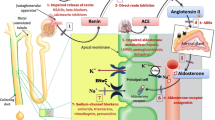Abstract.
In order to distinguish between normocitraturia and hypocitraturia, the 24 h urine excretion value of citric acid is evaluated in relation to the established limit value of 2.5 mmol/day. We propose changing this widely-used excretion value to a "minimum contribution" of citric acid to the total urine's ionic strength, since the inhibitory effect of citric acid on crystallization depends on citrate anions being available to complex calcium ions or to associate with the crystal surface. A total of 714 24 h-urine samples, taken from 74 healthy persons and 58 calcium stone formers, were investigated for pH, citric acid concentration ([CA]), and related relative calcium oxalate supersaturation (RS). Based on the Henderson-Hasselbalch-equation, the individual concentrations of the differently charged citrate anion species in each of the urines were calculated from the urinary pH and [CA]. From the anion concentrations determined, the contribution of the urine's citric acid to the total urine's ionic strength, ISCA, was calculated. Referring to the limit value of 2.5 mmol/day and assuming an average urine volume of 1.5 l/day, a hypothetical concentration limit of 1.67 mmol/l can be obtained. Grouping the samples into "stone-formers" and "non-stone-formers" as well as into three different ranges of RS revealed: (1) that the groups' median [CA]-values were below 1.67 mmol/l, and (2) that [CA] was not inversely associated with the risk of stone formation. Within the pH-range of 5 and 7, the ISCA-values which are related to, for example, [CA]=1.67 mmol/l, vary considerably by a factor of nearly three between 2.48 mmol/l and 6.64 mmol/l. The use of a fixed citric acid excretion level for the distinction of normocitraturia from hypocitraturia does not take into account the different citrate species which actually modify the urine's crystallization behaviour. The proposed ISCA approach takes this fact into consideration. From this parameter, a desirable "minimum impact of citric acid" can be derived. In a first approach, a potential ISCA-limit value, which currently distinguishes between urines indicated by a "normo-protective" impact and those indicated by a "hypo-protective" impact with respect to calcium oxalate precipitation, may be set at 2.48 mmol/l.
Similar content being viewed by others
Author information
Authors and Affiliations
Additional information
Electronic Publication
Rights and permissions
About this article
Cite this article
Laube, N., Jansen, B. & Hesse, A. Citric acid or citrates in urine: which should we focus on in the prevention of calcium oxalate crystals and stones?. Urol Res 30, 336–341 (2002). https://doi.org/10.1007/s00240-002-0272-3
Received:
Accepted:
Issue Date:
DOI: https://doi.org/10.1007/s00240-002-0272-3




